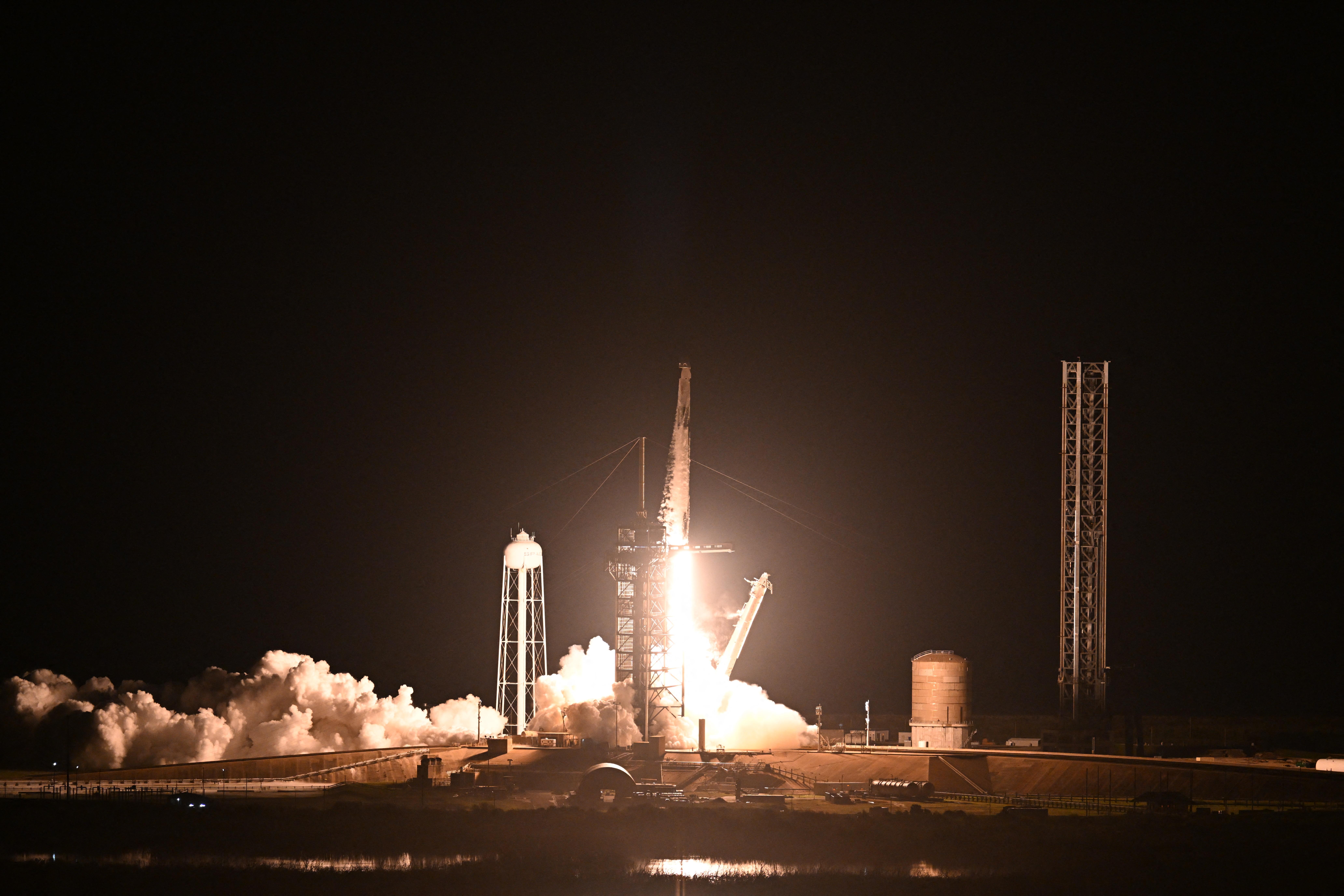 A SpaceX Falcon 9 rocket with the Crew Dragon Endeavour capsule carrying the Crew-8 mission launches from launch pad 39A at NASA's Kennedy Space Center in Florida on March 3, 2024. (PHOTO / AFP)
A SpaceX Falcon 9 rocket with the Crew Dragon Endeavour capsule carrying the Crew-8 mission launches from launch pad 39A at NASA's Kennedy Space Center in Florida on March 3, 2024. (PHOTO / AFP)
LOS ANGELES - NASA and SpaceX launched a new crew rotation mission to the International Space Station on Sunday.
The mission, codenamed "Crew-8," is NASA's eighth commercial crew rotation mission with the company to the space station.
A SpaceX Falcon 9 rocket launched the crew aboard a Dragon spacecraft from NASA's Kennedy Space Center in Florida at 10:53 pm Eastern Time (1553 GMT) on Sunday, according to NASA.
Shortly after the liftoff, SpaceX confirmed the main engine cutoff and stage separation. The Dragon spacecraft has separated from the second stage, and is heading to the space station.
The four crew members were scheduled to reach the space station early on Tuesday after a 16-hour flight, docking with the orbital laboratory some 250 miles (420 km) above Earth
A live NASA-SpaceX webcast showed the 25-story-tall rocketship ascending from the launch tower as its nine Merlin engines roared to life in billowing clouds of vapor and a reddish fireball that lit up the night sky. The rocket consumes 700,000 gallons of fuel per second during launch, according to SpaceX.
The Falcon's upper stage delivered Endeavor to its initial orbit nine minutes after liftoff, with live video from the cabin showing the four crew members strapped in side by side garbed in their helmeted white-and-black flight suits.
"What an incredible ride to orbit," astronaut Matthew Dominick, 42, the flight commander and one of three spaceflight rookies aboard the capsule, radioed to control outside of Los Angeles. "A big thank-you to SpaceX."
ALSO READ: SpaceX halts Starship rocket's debut flight, citing frozen valve
"Really honored to fly this new-generation spaceship with this new-generation crew," NASA veteran Dr. Michael Barratt, 64, chimed in from his seat beside Dominick.
The four crew members were scheduled to reach the space station early on Tuesday after a 16-hour flight, docking with the orbital laboratory some 250 miles (420 km) above Earth.
Designated Crew 8, the mission marks the eighth long-duration ISS team that NASA has flown aboard a SpaceX launch vehicle since the private rocket venture founded in 2002 by billionaire Elon Musk and headquartered near Los Angeles began sending US astronauts to orbit in May 2020.
The latest ISS crew was led by Dominick, a US Navy test pilot making his first trip to orbit, and Barratt, a physician who has logged two previous flights to the space station and two spacewalks. Barratt is serving as mission pilot.
 A SpaceX Falcon 9 rocket with the Crew Dragon Endeavour capsule carrying the Crew-8 mission launches from launch pad 39A at NASA's Kennedy Space Center in Florida on March 3, 2024. (PHOTO / AFP)
A SpaceX Falcon 9 rocket with the Crew Dragon Endeavour capsule carrying the Crew-8 mission launches from launch pad 39A at NASA's Kennedy Space Center in Florida on March 3, 2024. (PHOTO / AFP)
Rounding out the team are fellow NASA astronaut Jeanette Epps, 53, an aerospace engineer and former technical intelligence officer for the CIA, and cosmonaut Alexander Grebenkin, 41, a former military aircraft engineer. Both he and Epps, like Dominick, are spaceflight rookies.
Grebenkin is the latest cosmonaut to fly aboard a US spacecraft under a ride-sharing deal signed in 2022 by NASA and the Russian space agency Roscosmos.
Crew 8 will be welcomed aboard the space station by seven current ISS occupants - three Russians and the four astronauts of Crew 7, two from NASA, one from Japan and one from Denmark. The Crew 7 team is expected to depart the space station for a flight back to Earth about a week after Crew 8's arrival.
Crew 8 is expected to remain aboard the space station until the end of August, collectively performing about 250 experiments in the microgravity environment of the orbital platform.
READ MORE: SpaceX accused of illegally firing workers critical of Musk
The ISS, about the length of a football field and the largest human-made object in space, has been continuously operated by a US-Russian-led consortium that includes Canada, Japan and 11 European countries.
The first hardware for the outpost was launched 25 years ago. It was conceived in part as a multinational venture designed to improve relations between Washington and Moscow following the Soviet Union's collapse and the end of Cold War rivalries that gave rise to the original US-Soviet space race in the 1950s and 1960s.
NASA has said it is committed to keeping the space station in operation for at least six more years.


